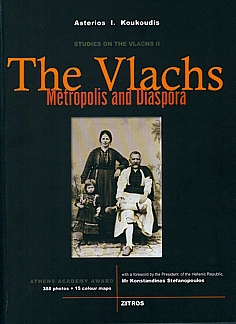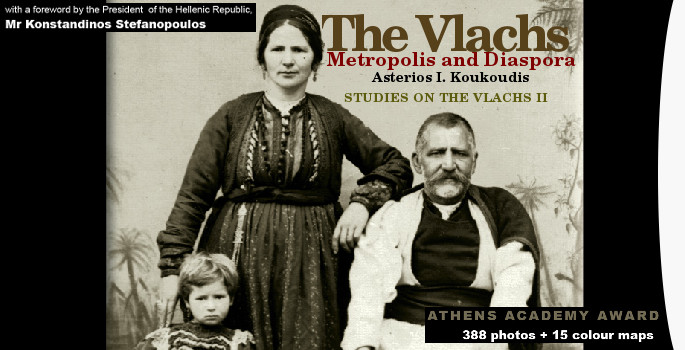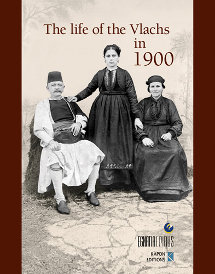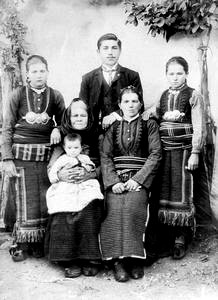
The Vlachs: Metropolis and Diaspora
Studies on the Vlachs - 2nd vol.
hard cover 28x21 cm
516 pages, 15 colored maps
388 old black and white pictures
Zitros Publications, Thessaloniki 2003
Foreword by the Director Yannis Z. Drossos
Table of contents
Table of contents
THE VLACHS: METROPOLIS AND DIASPORA
I. The Vlachs of the Southern Pindos
The Vlachs of Aspropotamos and Malakassi
1. General
1.1. The Vlach villages of Aspropotamos
1.2. The Vlach villages of Malakassi
‘Hora Metsovou’ and Vlahodzoumerko
2. The Byzantine period: ‘Great Vlachia’
3. References to the Vlach villages in Aspropotamos and Malakassi in the mediaeval and Byzantine period
4. The Ottoman period until the 17th century
5. The exoduses of the 17th century
5.1. The reasons for the exoduses
5.2. To eastern Thessaly, Kissavos, and Pilio
5.3. To Olympos
5.4. To Thessaloniki
5.5. To Moschopolis
6. ‘Hora Metsovou’: the privileges of the Metsovo area
7. The 18th century: economic and cultural development
7.1 The conditions and the agents of development
7.2. Aspects of the remarkable development of the Vlach villages
8. Later exoduses, 1769–1830
8.1. Events associated with the Orlofika
8.2. The dominion of Ali Pasha of Ioannina
8.3. The War of Independence of 1821
9. The Vlach population in Thessaly after incorporation in 1881
Notes I
II. The Vlachs of Zagori and Konitsa
1. General
1.1. Zagori
1.2. The Vlach villages of Konitsa
2. The Byzantine period
3. The Ottoman period from 1430 to 1684
3.1. The general situation
3.2. Demographic and ekistic development and changes between 1430 and 1684
3.2.1. Vlahozagoro
3.2.2. The debate about the former extent of Vlahozagoro
3.2.3. The Vlach villages of Konitsa
4. The Ottoman period from 1684 to 1868
4.1. The ‘Zagori Federation’
4.2. The economy of the Vlach villages of Zagori and Konitsa
4.3. The reasons for the population drain from the Vlach villages of Zagori and Konitsa between 1769 and 1830
4.3.1. The exoduses from Vovoussa
4.3.2. The exoduses from Fourka
5. Emigration in the modern era (second half of the 19th and first half of the 20th century)
Notes II
III. The Vlachs of the Northern Pindos: The Vlach villages in the Grevena area
1. General
1.1. The transhumant Vlach villages
1.2. The permanent Vlach villages
1.3. The Kupatshari
2. The Vlachs’ pastoral nomadism
3. The Byzantine period
4. The Ottoman period I: 15th–17th cent.
4.1. Samarina
4.2. Perivoli
4.3. Avdella
4.4. Smixi
4.5. Krania
5. The Ottoman period II: 18th–19th cent.
5.1. Economic data
6. The exoduses between 1769 and 1830
6.1. The exoduses associated with the collapse of Moschopolis and the Orlofika, 1769–71
6.2. The exoduses in the time of Ali Pasha and the Greek War of Independence, 1788–1830
6.2.1. Exoduses from Samarina
6.2.2. Exoduses from Perivoli
6.2.3. Exoduses from Avdella
6.2.4. Exoduses from Smixi
7. The rebellion of 1854 and the exoduses in the mid-19th century
8. The departure of the Batuts from Samarina (1856–60)
Notes III
IV. The Arvanitovlachs
1. General
2. The Byzantine period
3. The Ottoman period until 1821
4. The Arvanitovlachs in Epiros and Albania after 1821
5. The Arvanitovlachs in Macedonia
6. The Arvanitovlachs in Thessaly
7. The Arvanitovlachs in Roumeli (Mainland Greece)
Notes IV
V. The Vlachs of Moschopolis and the surrounding area
1. General
2. The Byzantine period
2.1. The first references
2.2. Moschopolis and the Arvanitovlachs
2.3. The first settlement
3. The Ottoman period until 1769
3.1. From the Ottoman conquest to 1700
3.2. The glory days, 1700
4. The collapse of Moschopolis and the surrounding Vlach villages
4.1. The circumstances of the first great collapse in 1769
4.2. The events of 1769
4.3. The events of 1788
5. The mass exoduses
5.1. To Western Macedonia
5.2. To Central Macedonia
5.3. To Eastern Macedonia and Eastern Rumelia
5.4. To Fyrom and Kosovo
5.5. To the Pindos, Epiros, and Thessaly
5.6. To Albania
5.7. To the northern Balkans (Serbia) and the Habsburg Empire
6. Moschopolis and the surrounding area after the mass exoduses
Notes V
VI. The Vlachs of Grammos
1. General
2. The Grammoustian Vlachs’ points of departure
2.1. Nikolice
2.2. Arrez
2.3. Darde
2.4. Linotopi
2.5. Ayios Zaharias
2.6. Aetomilitsa
2.7. Kiafa
2.8. Grammousta
2.8.1. From foundation to mass exodus
2.8.2. The mass exoduses from Grammousta
2.8.3. The differentiation of the Grammoustian Vlachs
2.8.4. The diaspora and the colonies of the Grammoustian Vlachs
2.8.5. Foussa and Veterniko
2.8.6. Grammousta after its decline
3. Later Arvanitovlach groups in the Grammos area
Notes VI
VII. The Vlachs in north-western Macedonia
1. General
1.1. Vlach villages and settlements in Western Macedonia
1.2. Vlach villages and settlements in south-western Fyrom
1.3. Vlach villages and settlements in the rest of Fyrom
2. The Byzantine period
3. The Ottoman period
3.1. From the end of the 14th century to c. 1769
3.2. The Vlachs and the Mijaks
3.3. From 1769 to 1912
3.3.1. The exoduses from Moschopolis, the surrounding area, and the area of Grammos to join older Vlach communities and establish new ones
3.3.2. Demographic changes in the time of Ali Pasha of Ioannina and until the mid-19th century
3.3.3. Migratory movements during the 19th century and until 1912
4. The Vlach refugees from Pelagonia after 1912







